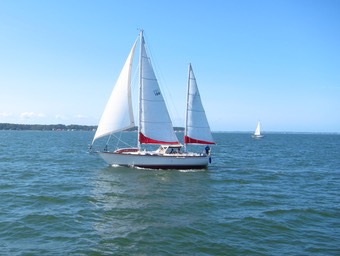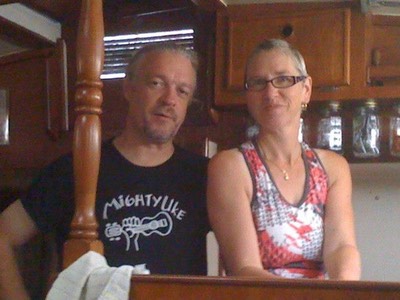Travel 2018-2019
Center Fuel Tank
I think — or perhaps I hope — I’ve solved a serious problem. I have a theory about diesel fuel in the bilge.
Last winter, a hose clamp for the deck drains failed. The winter rains and snowmelt poured into the engine room, and the deep bilge. It froze. The pump broke. The bilge filled to a remarkably high level.
See The Drain Hose for some background. We have diesel in the bilge and on top of the center fuel tank.
I pumped the bilge dry, carrying bucket after bucket to the bilge-water recycling barrel.
Then it was summer and time to go sailing. Most times we got back there would be diesel in the bilge. I’d shut off the pump, manually pump out the bilge, and carry bucket after bucket to the bilge-water recycling barrel.
Tedious, messy stuff.
I think I must have pumped at least 30 gallons of bilge water contaminated with diesel. Possibly more.

My theory is the drain hose filled the center tank, and the diesel is floating on top of the water, and leaking out around the cover plate the same way rain water is leaking in. Indeed, there’s an exchange: each gallon of water leaking in displaces a gallon of diesel to leak out.
You can see the red-died fuel in the middle of this picture, with the vent hose sticking out of it.
This weekend, I finally had time to take it very seriously.
Very.
There’s a tiny vent fitting on the top of the tank. With a vent hose. I can take the hose off, and use the wand on my oil-change pump to pump fluid from the center tank. I pumped out something like 10 gallons of fuel, and the pump started gurgling because the level had fallen and the pump was only getting air.
I pushed the wand in exactly one more inch. Pumped out another eight to ten gallons of fuel. The third round — I’m now down to about 4” — I got another eight to ten gallons of almost entirely fuel. The fourth round — 5” in — I get water!
I pumped until I get down to air, and most of what I got was water. Water with a little bit of fuel. At this point, there are still traces of fuel in the center tank. If I’m right, and it’s the source of diesel in the deep bilge, I won’t see anything for the next few years. Then, perhaps, traces of diesel once the tank is full again.
Or.
I’m wrong and the fuel is coming from a massive hole somewhere else. A hole that only seems to leak when we’re under way. A leak that doesn’t let fuel into the pan under the engine, but somehow lets fuel into the deep bilge. And it’s not leaking onto the floor of the pass-through. Nor is it visible on the sides of the hull above the bilge. Somehow it’s leaking in a way that means it’s only visible on the top of the center fuel tank.
About The Temperature Gauge
On Thursday, we dialed the speed up to 7 knots. This means a bit over 2,000 RPM on the tach.
And the temperature started to increase. And increase. I don’t often check the temperature. But I did manage to notice it in time.
Did I mention we had guests?
We had guests. See Friends and Boats. First-timers on Red Ranger, too, so everything’s mysterious and a little scary.
I pull the throttle back. I run below, calling out, “Nothing to worry about. Remain calm.” As if that makes anyone feel calm.
There’s no cooling water spraying around the engine room or bilge. (whew!) There’s a lot of steam coming out the exhaust pipe. With the gauge over 200°F, Cooling water is boiling away. Which makes sense.
There were no alarms. Yet.

At low RPM’s, the temp fell. At high RPM’s it rose.
Possible cause 1. Blockage in the input — i.e., grass in the strainer.
Possible cause 2. Failing impeller in the raw water pump.
Remotely possible causes include broken or leaking hoses or jammed up heat exchangers.
Saturday, CA cleaned the strainer. She found grass. ✅
I took out the impeller. You can see a vane partially missing. ✅
I poured the water out of the oil cooler and didn’t see any obvious rubbery parts. So. I’m guessing the busted up pieces flowed on through the system and out the exhaust.
Ran the engine at idle to pressure test it when I was done. Worked.
Now to run up the RPM’s and race around at 7 knots again to see if it’s fixed.
Friends and Boats
Brought some friends — David and Bo — along to move Red Ranger from West River back down to Herrington Harbour.

They’d never seen Red Ranger before, and hadn’t fully appreciated how much boat she is.
The winds were light, and — of course — on the nose, so we motored for an hour or so. Revisited old times. Talked about family. Planned future parties.
When the wind clocked a bit, we could put up the sails for another couple of hours, and drift down the bay, close-hauled.
It was an ideal afternoon.
They had to continue on to Virginia Beach, so they spent a night in a nearby hotel before leaving in the morning to continue south.
Whitby-Brewer Rendezvous 2018
Another year of fun and sharing! There’s a lot we can learn from other sailors with the same boats and a wide variety of experiences. An important lesson from this year is how long it takes before we’re talking about the ship’s head. (For non-sailors, read “toilet.”)

For the 2018 edition of the rendezvous, we had four boats at the dock of the West River Sailing Club:
- Red Ranger
- Shooting Star
- Wild Oats
- Allegria
We had almost two dozen attendees reflecting — perhaps — a dozen boats. James and Christine won the prize for coming all the way from Calgary, Alberta, some 2,300 miles. We keep Red Ranger at Herrington Harbour North, so our trip was about 15 miles: 3 hours by boat. Shooting Star and Wild Outs, similarly, are close by. Allegria, however, came down from from Newfoundland.
Some Whitby-emeritus owners (Ted, Alice, John, and Mary) live in the area so, they win the prize for shortest distance traveled.
There are some key ingredients for a proper rendezvous.
Introductions. And a boat card exchange. We all describe our boat and our favorite locations. We get to meet the folks we don’t know, greet the folks we've met before. We learn about folks new to the group, and new to their boars, as well as the folks with thousands of sea miles under their keels.

Shared Meals. We use the West River Sailing Club and Betka’s Real Food catering service provided us wonderful meals Monday night, all day Tuesday and all day Wednesday, also.
Boat Tours. With four boats at the dock, we can swap ideas, and learn from each other. I’ve seen these three boats several times before, and I’m starting to understand some of the smaller differences between them.
Program. Ruth of Shooting Star built an amazing program this year. She seems to know a huge number of cruisers, and invited lots of them to speak.
- Jeanie and Scott talked about the Whitby-Brewer web site. Jeanie explained the detailed history of the boats she’s collected. This history can help a buyer learn about previous owners and previous names for a boat you’re thinking about buying. It also helps when you see a boat and wonder who you should hail on the VHF.
- Fred reviewed the rules of the road. “Red over Red, Captain is Dead.” Okay. It’s silly, but we’ve learned to recognize the lights of a ship not under command.
- Monty and Sara — the folks who publish Explorer Chartbooks — stopped by to tell us how and why they put their unique offering together. We learned about coloring scheme for the hydrography and their policy for stating depth. The books include tons of need-to-know information about the Bahamas. Since they offered us a discount, we bought the latest editions.
- Dee and Molly told us about their trip up the coast of Newfoundland. They shared details of anchorages, and spectacular photos. This wasn’t their first trip up north, and we learned how they managed the persistent SW winds they encountered.
- Molly Winans— editor of Spinsheet Magazine — told us about sailors and the twelve reasons why she loves sailors. Stories from a master story-teller are a delight.
- We demonstrated how flares work. We tried 12-gauge and 25mm flare launchers, signal rockets, SOLAS flares, and (cheap) locator flares. Out-of-date flares really do work. We saw how the pistol-like flare launchers can be unimpressive: a 12 gauge flare with a six-second burn is barely visible. If you’re going to use this, have a generous supply. The 25mm launcher with converter sleeve didn’t work out very well, either: when the flare misfired, it wound up jammed in the sleeve. Have multiple sleeves in case of misfires. The demonstration required a fair amount of coordination with US Coast Guard, Galesville Fire Department, Maryland Department of Natural Resources, and local businesses to be sure everyone was aware of what we were doing. You can see Molly’s Facebook post of our flare demo.
Day two was just as informative and helpful:
- Brian Smith from American Diesel stopped by to help us understand our diesel engines. We talked about a number of topics, including the frequency of oil changes and the complexities of getting all the oil out of the pan. We learned about the importance of looking closely at your oil as a diagnostic tool for how your engine is running.
- Kathy Barth from Seven Seas Cruising Association told us of the many benefits of SSCA membership. We have several members — and at least one commodore couple— in the Whitby family. What we’re doing is like an SSCA Gam on a smaller scale.
- We shared our stories of things that work — and things that don’t. As Milly Winans pointed out, it’s only about ten minutes before we’re talking about the boat’s head and the various complexities of marine sanitation devices.
- After lunch we had a brief business meeting to examine our finances. We pay for Whitby Brewer Sailboats. The rendezvous pricing is designed to break exactly even with the fees for Real Food and the West River Sailing Club. And that’s it. We have a couple of people who handle the tiny dribble of money. Ruth, Cindy Ann, and Maureen put the program together for the rendezvous.
- Steve showed how rock climbing safety techniques can be applied to ascending the mast. Use proper 22 kn rated carabiner clips, and use a figure-eight with follow-through knot for anything you’re climbing on.
And then we moved on to visiting boats, having hors d'oeuvre and then eating a delightful dinner.

An associated event can help. In this case, the Annapolis sailboat show starts the next day. Some of use will sail up to Annapolis to make last-minute purchases before heading south.
A bonus this year was yoga at 07:00 both mornings. CA finished her instructor training at Blue Nectar recently. The morning program was designed to build up some strength and flexibility based on the kind of activities common on a sailboat.


